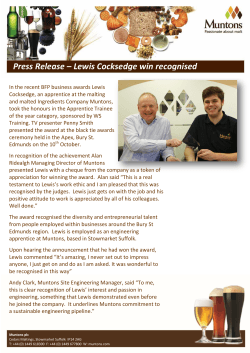
Handout
Testing Lewis Formulas and VSEPR Models with Quantum Theory Copyright 2014 John W. Keller Experiment Sections I Draw Lewis formulas for three ions or molecules in one group. Predict each molecular geometry using VSEPR theory. II Use quantum theory (WebMO) to test your geometry predictions. III Build plastic models of one or more molecules or ions in Part I. IV Use WebMO to investigate a Lewis formula containing resonance forms. V Display a sigma (σ) molecular orbital and a pi (π) molecular orbital. VI Advanced options. Analyze bond angles and dipole moment in a molecule from Part I; or use the Internet to find information on complex molecular shapes. I. Lewis formulas and VSEPR predictions Draw the Lewis formula for the molecule or ion in the shaded box in your assigned group, plus TWO OTHERS in that group. Use 3 worksheets, one for each molecule or ion. First draw the Lewis formula, and then predict the molecular geometry using VSEPR theory. In Part II test your predictions using quantum theory calculations. You may wish to test each prediction by going immediately to Part II, then returning to draw the next Lewis formula on a fresh worksheet. Group “br” = branched; “nonbr” = not branched; atoms in a row. (Where it may be ambiguous, the underlined and BOLD atom is central.) 1 BFCl+ (nonbr) COCl2 (br) SeO32- (br) SCl2F2 (br) 2 ClFO3 (br) FCCF (nonbr) H3S+ (br) SCN- (nonbr) 3 ClClO (nonbr) CS(NH2)2 (br) NCO- (nonbr) SSO22- (br) 4 ClF4- (br) CNH(NH2)2 (br) FNNF (nonbr) SClFS (br) 5 FCO(OH) (br) NCS- (nonbr) SiH2F2 (br) ONOO- (nonbr) 6 CNO- (nonbr) CO(OH)2 (br) SiClF3 (br) SSSS2- (nonbr) 1 II. Test molecular geometry using WebMO and PM3 1) Click the “24 molecules and ions” link at this experiment’s website (obtain the URL or hyperlink from your instructor). Follow the link of an assigned molecule to a webpage showing two or three 3D structures. Keep that page open for the next step. 2) Use WebMO and the PM3 quantum method to calculate the heat of formation of all geometries shown (some have 2, others 3). Record each heat of formation on the worksheet for that molecule or ion. 3) Now: Is your VSEPR predicted geometry the same as the geometry with the lowest energy? Hopefully, yes. Your back-of-the-envelop sketch has been verified by quantum theory! 4) If not, check your original Lewis formula and VSEPR prediction. Perhaps revise the Lewis formula, or re-calculate “electron pair geometry” and “molecular geometry” so that they are consistent with the structure having the lowest energy. (No need to erase your original formula: there is no penalty for getting an incorrect geometry. In fact, comparing correct and incorrect formulas is a great way to learn about—and remember—the VSEPR theory.) III. Build plastic models Choose at least one of the (correct) geometries and build a plastic model. See the handout HGSandScholARmodels.pdf on the ex periment website. For resonance stabilized ions or molecules, only one resonance form can be built at a time. IV. Resonance Background. It seems that fairly often, especially when molecules contain double or triple bonds and nearby lone pairs, the bonds and lone pairs can be arranged in different ways to satisfy the Octet Rule. If these 2 or 3 formulas are reasonable, then the actual bonding is considered to be a hybrid of all these formulas. This is an admittedly confusing situation, but it arises because some molecules contain a bond that stretches across 3, 4 or more atoms. A multi-atom bond like this cannot be represented by the customary line between 2 atoms, so drawing 2 or more resonance forms is the best way to represent these bonds with Lewis formulas. In fact, the same atoms where the variable bonds are placed are the same ones that contain the multi-atom bond. A multi-atom bond is a pi-type bond (π-molecular orbital) which can be thought of as the summation of several parallel p-orbitals. 2 Group Resonance-stabilized molecule (or ion) 1 COCl2 2 SCN- 3 NCO- 4 CNH(NH2)2 5 ONOO- 6 CO(OH)2 1. Anyway, if you have not done so already, draw as many resonance forms as possible (that obey the Octet Rule) for the ion or molecule in your group as shown above. Be sure to include in your formulas the correct formal charge for any atom with a non-zero formal charge. See section 9.7 in Chang for more help with formal charges. ***Your TA should check your resonance formulas first before continuing to WebMO.**** 2. Do these formulas actually represent physically different ions or molecules? We can provide a definitive answer using quantum theory. First, use WebMO and PM3 to optimize the geometry of one resonance form. 3. Next, optimize the geometry of the other resonance form(s). Compare the energies, bond lengths, and charge distributions of the 2 (or 3) jobs. Are they the same, or different? If they are indeed resonance forms, their energies and other parameters should be identical. (If the energy of the second resonance form WebMO job is different, it’s possible that a setting on the input page of WebMO was incorrect, such as the charge or multiplicity. Or, in the case of ONOO-, it has two possible shapes: curved or zig-zag. Either one is OK, but make sure both calculations use the same shape.) 3 V. Sigma (σ) and Pi (π) Molecular Orbitals In WebMO again, open one of your resonance jobs, click “New Job Using This Geometry” at the bottom of the window. Continue. Continue. Now under Calculation, choose Molecular Orbitals. Continue. When completed, see the results by clicking the job name, and go to the table near the bottom of page. The bonding molecular orbitals (MOs) are the ones with “population = 2 electrons”. Draw, or print out, one sigma and one pi bond for your molecule. A pi (π) bond is two-sided, with electron density zones appearing above and below the plane of the bonded atoms. Pi bonds are formed by overlap of atomic p-orbitals. MO 6 in the video example is a π-bond. A sigma (σ) bond lies in the plane of the bonded atoms. Sigma bonds are formed by overlap of s- or p-orbitals. In some molecules or ions in this experiment, the type of MO is already labeled “σ” or “π” in column 2 of the results page. View an MO by clicking the magnifying glass icon on the right side of the table. The style of the MO display is controlled by the Preferences menu. If the MOs are not labeled “σ” or “π”, just choose one that is several steps in energy lower than the highest occupied MO. If that is not to your liking, display another one by clicking a different MO number in the left column. This button opens the Preferences box. Click a number here to display another MO. MO 6 of thioformateion is a π-bond extending over 3 atoms. The volume of the orbital, or equal probability surface, is controlled by the iso value: 0.03 gives a reasonable surface. The surface style or opacity is controlled by the Opacity slider. There 4 choices (l-to-r): none, mesh (shown here), translucent, and opaque. 4 Review Topics Review the topics below in your textbook. You may also wish to bring the text to lab, or open these sections online. However, it is vital that you have some skill in drawing Lewis formulas and calculating formal charge before coming to lab. o Topic Heat of Formation ∆fH Drawing Lewis formulas and formal charge Valence Shell Electron Pair Repulsion (VSEPR) theory The Schrödinger Equation and quantum theory of atoms Resonance Molecular orbitals 5 Sections in Chang 6.6 9.6, 9.7 10.1 7.5 9.8 10.6, 10.7, 10.8
© Copyright 2025








